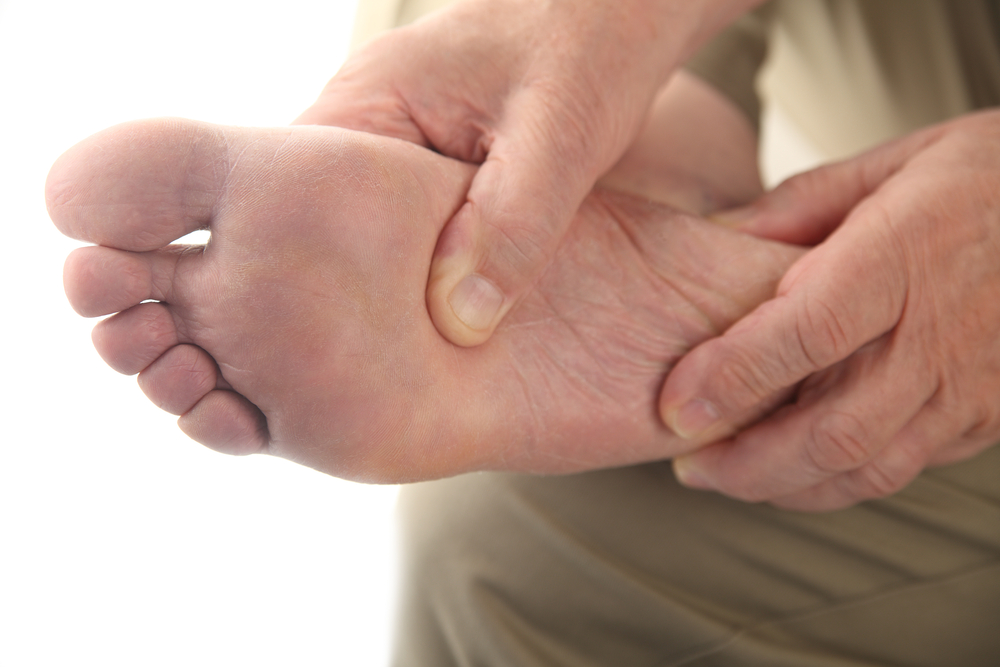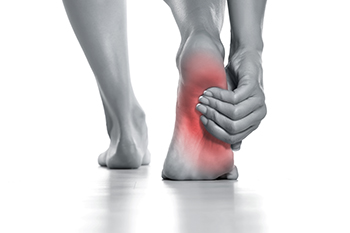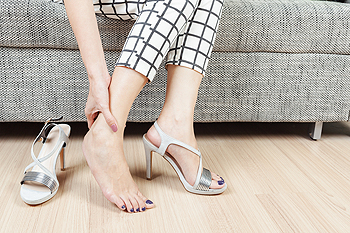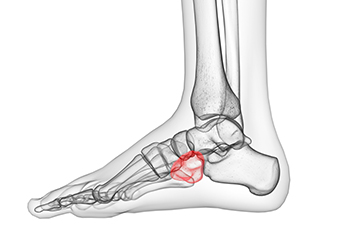
Consulting a podiatrist for diabetic foot care is essential for individuals with diabetes. Diabetes can cause neuropathy, which is a loss of sensation in the feet, making it difficult for patients to feel injuries, blisters, or sores. This numbness can lead to unnoticed and untreated wounds, which can quickly become infected due to compromised immune responses often seen in diabetic patients. In addition to neuropathy, diabetes can cause poor circulation, making it harder for wounds to heal and increasing the risk of infections. If untreated, these infections can lead to ulcers and gangrene. If you have diabetes, it is strongly suggested that you make regular appointments with a podiatrist to maintain overall foot health and reduce the risk of foot complications.
Diabetic foot care is important in preventing foot ailments such as ulcers. If you are suffering from diabetes or have any other concerns about your feet, contact Brian Shwer, DPM from Southaven Foot Clinic. Our doctor can provide the care you need to keep you pain-free and on your feet.
Diabetic Foot Care
Diabetes affects millions of people every year. The condition can damage blood vessels in many parts of the body, especially the feet. Because of this, taking care of your feet is essential if you have diabetes, and having a podiatrist help monitor your foot health is highly recommended.
The Importance of Caring for Your Feet
Patients with diabetes should have their doctor monitor their blood levels, as blood sugar levels play such a huge role in diabetic care. Monitoring these levels on a regular basis is highly advised.
It is always best to inform your healthcare professional of any concerns you may have regarding your feet, especially for diabetic patients. Early treatment and routine foot examinations are keys to maintaining proper health, especially because severe complications can arise if proper treatment is not applied.
If you have any questions please feel free to contact our office located in Southaven, MS . We offer the newest diagnostic and treatment technologies for all your foot and ankle needs.

Experiencing arch pain in your foot can be uncomfortable and potentially lead to complications if not addressed promptly. As the pain persists or worsens, seeking help from a podiatrist is essential. This medically trained foot doctor can employ various techniques to diagnose the underlying causes of your arch pain. During a physical examination, the doctor assesses the pain's location, evaluates ligaments, and checks for signs of infection or inflammation. Taking X-rays can provide a comprehensive view of the foot's structure, which aids in detecting structural problems or injuries that may be contributing to the pain. In more complex cases, advanced imaging techniques, like MRI and CT scans, offer detailed images of bones and tendons, enabling a more precise diagnosis. In certain situations, an ultrasound scan may be recommended for pinpoint accuracy. Rest is fundamental, involving a break from activities that stress the feet. Supportive shoes with arch supports and night splints for conditions like plantar fasciitis can also provide relief. For help in dealing with pain in the arch of your foot, it is suggested that you make an appointment with a podiatrist.
Foot Pain
Foot pain can be extremely painful and debilitating. If you have a foot pain, consult with Brian Shwer, DPM from Southaven Foot Clinic. Our doctor will assess your condition and provide you with quality foot and ankle treatment.
Causes
Foot pain is a very broad condition that could be caused by one or more ailments. The most common include:
Diagnosis
To figure out the cause of foot pain, podiatrists utilize several different methods. This can range from simple visual inspections and sensation tests to X-rays and MRI scans. Prior medical history, family medical history, and any recent physical traumatic events will all be taken into consideration for a proper diagnosis.
Treatment
Treatment depends upon the cause of the foot pain. Whether it is resting, staying off the foot, or having surgery; podiatrists have a number of treatment options available for foot pain.
If you have any questions, please feel free to contact our office located in Southaven, MS . We offer the newest diagnostic and treatment technologies for all your foot care needs.

High heels are often celebrated for their fashionable appearance, but it is essential to recognize their potential negative effects on foot health. These stylish shoes can lead to a range of foot problems. First, they alter the natural position of the foot, forcing it into an unnatural shape that puts excessive pressure on the toes and the ball of the foot. This can lead to pain and discomfort and may contribute to conditions such as bunions or hammertoes. Additionally, high heels can affect balance, increasing the risk of ankle sprains or fractures. Prolonged wear of high heels can lead to Achilles tendon shortening, causing pain and reduced flexibility. While high heels may enhance your outfit, it is vital to prioritize your foot health. Opting for comfortable, supportive footwear when possible and limiting high-heel use can help mitigate these negative effects on your feet. If you are interested in gathering more information about the negative effects high heels can have on your feet, it is suggested that you confer with a podiatrist who can provide you with the information you are seeking.
High heels have a history of causing foot and ankle problems. If you have any concerns about your feet or ankles, contact Brian Shwer, DPM from Southaven Foot Clinic. Our doctor can provide the care you need to keep you pain-free and on your feet.
Effects of High Heels on the Feet
High heels are popular shoes among women because of their many styles and societal appeal. Despite this, high heels can still cause many health problems if worn too frequently.
Which Parts of My Body Will Be Affected by High Heels?
What Kinds of Foot Problems Can Develop from Wearing High Heels?
How Can I Still Wear High Heels and Maintain Foot Health?
If you want to wear high heeled shoes, make sure that you are not wearing them every day, as this will help prevent long term physical problems. Try wearing thicker heels as opposed to stilettos to distribute weight more evenly across the feet. Always make sure you are wearing the proper shoes for the right occasion, such as sneakers for exercising. If you walk to work, try carrying your heels with you and changing into them once you arrive at work. Adding inserts to your heels can help cushion your feet and absorb shock. Full foot inserts or metatarsal pads are available.
If you have any questions please feel free to contact our office located in Southaven, MS . We offer the newest diagnostic and treatment technologies for all your foot and ankle needs.

A network of plantar digital nerves in the feet supply sensory signals to the forefoot and toes. Problems arise when these nerves encounter compression, which can occur when the toes are consistently pressed together, effectively obstructing the pathway for these nerves. Such compression often causes a condition known as Morton's neuroma. This may be the result of wearing high heels that force body weight onto the ball of the foot. When the plantar nerves become entrapped, their ability to efficiently transmit signals is affected. This leads to symptoms, including sharp, burning, or tingling sensations in the forefoot and toes. Individuals with Morton's neuroma may also experience numbness or the feeling of having a pebble or foreign object in their shoe. Morton's neuroma can be effectively managed in several ways. Start with footwear that has cushioning and provides adequate room for the toes. Custom orthotics can also help alleviate pressure on the affected area. In more severe cases, corticosteroid injections or surgical intervention may be recommended. If you suspect you are suffering from Morton's neuroma, it's suggested that you make an appointment with a podiatrist for a diagnosis and treatment plan tailored to your needs.
Morton’s neuroma is a very uncomfortable condition to live with. If you think you have Morton’s neuroma, contact Brian Shwer, DPM of Southaven Foot Clinic. Our doctor will attend to all of your foot care needs and answer any of your related questions.
Morton’s Neuroma
Morton's neuroma is a painful foot condition that commonly affects the areas between the second and third or third and fourth toe, although other areas of the foot are also susceptible. Morton’s neuroma is caused by an inflamed nerve in the foot that is being squeezed and aggravated by surrounding bones.
What Increases the Chances of Having Morton’s Neuroma?
Morton’s neuroma is a very treatable condition. Orthotics and shoe inserts can often be used to alleviate the pain on the forefront of the feet. In more severe cases, corticosteroids can also be prescribed. In order to figure out the best treatment for your neuroma, it’s recommended to seek the care of a podiatrist who can diagnose your condition and provide different treatment options.
If you have any questions, please feel free to contact our office located in Southaven, MS . We offer the newest diagnostic and treatment technologies for all your foot care needs.

Cuboid syndrome, though relatively rare, is a painful condition that affects the cuboid bone in the foot. Understanding its causes and recognizing the symptoms is crucial for timely diagnosis and effective treatment. One of the primary causes of cuboid syndrome is an injury or trauma to the foot, such as a sudden twist or strain. This can dislocate, or subluxate, the cuboid bone, leading to pain and discomfort. Athletes, especially those involved in activities requiring repetitive foot movements, are more prone to this condition. The noticeable symptom of cuboid syndrome is pain on the lateral side of the foot, typically around the midfoot area. This pain can be sharp, stabbing, or aching, and it often worsens with weight-bearing activities like walking or running. You may also experience swelling and limited range of motion in the affected foot. Treatment options may include rest and taping, in addition to realigning the cuboid bone. Early intervention can help alleviate symptoms and prevent long-term issues. If you have pain on the outside of your foot, it is suggested that you visit a podiatrist who can accurately diagnose and treat cuboid syndrome.
Cuboid syndrome, also known as cuboid subluxation, occurs when the joints and ligaments near the cuboid bone in the foot become torn. If you have cuboid syndrome, consult with Brian Shwer, DPM from Southaven Foot Clinic. Our doctor will assess your condition and provide you with quality foot and ankle treatment.
Cuboid syndrome is a common cause of lateral foot pain, which is pain on the outside of the foot. The condition may happen suddenly due to an ankle sprain, or it may develop slowly overtime from repetitive tension through the bone and surrounding structures.
Causes
The most common causes of cuboid syndrome include:
Symptoms
A common symptom of cuboid syndrome is pain along the outside of the foot which can be felt in the ankle and toes. This pain may create walking difficulties and may cause those with the condition to walk with a limp.
Diagnosis
Diagnosis of cuboid syndrome is often difficult, and it is often misdiagnosed. X-rays, MRIs and CT scans often fail to properly show the cuboid subluxation. Although there isn’t a specific test used to diagnose cuboid syndrome, your podiatrist will usually check if pain is felt while pressing firmly on the cuboid bone of your foot.
Treatment
Just as the range of causes varies widely, so do treatments. Some more common treatments are ice therapy, rest, exercise, taping, and orthotics.
If you have any questions, please feel free to contact our office located in Southaven, MS . We offer the newest diagnostic and treatment technologies for all your foot care needs.